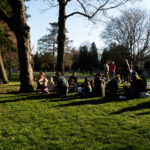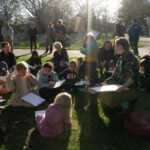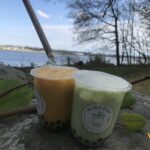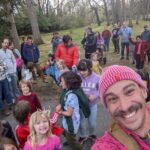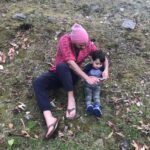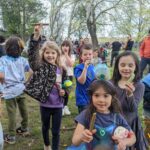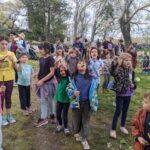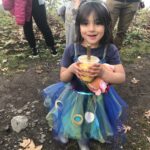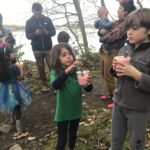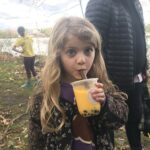Back in February/March this year, I started talking with the library about running some kind of class with them. After sitting down and talking with them, though, I realized that the way we run classes in schools doesn’t work in libraries. In schools, kids are* in the same class, day after day, week after week, so you can run a sequential class that builds on previous classes. In a library, *especially* a kid’s library, people come and go as they please. The sequential class structure wouldn’t work. I had to fink about this for a sec, because all the teaching materials we’d been building were for sequential classes.
*well, at least in theory
That afternoon, by pure chance, I was hanging out with other parents at my daughter’s school during pickup. I mentioned to another dad that I’d seen a screech owl in a nest that day, and a kid overheard and was curious. Before long, five more curious kids popped up, so I offered to bring everyone over to have a look at the owl. Like a snowball, one kid told another told another, and eeeeveryone wanted to come see an owl. Soon, a convoy of cars followed us to the local cemetery for an impromptu owl viewing. I ran home to grab my camera and long lens as a way, and set it up so that kids could see the faraway animals on the camera screen without disturbing the owls. Another parent took this picture while we were in the middle of things.

The gears in my head started turning after that, and I pitched that we run a ~2-month class meeting with families once a week, after work. In honor of our first foray with children, we called it the Owl Prowl. The library didn’t have budget for this first class, so Jasmine and I found a group called the Gathering of Ocean Science Hardware that was offering $500 micro-grants for running science-y events, and we put an application together. Most applicants were using their funding for materials or space rental, but for us, we had space in the cemetery and the materials were all there in nature — we mostly just needed something to pay my teachers for running programs. In the stuff-oriented world of science, we were the weirdos here — I think we came in eigtheenth out of twenty applicants in the review process, but hey, we got the grant, and we got cracking!

The whole thing came together in a few days. We intentionally didn’t do any signup process — just told folks to come meet us at the cemetery gates at 5pm on Mondays, and we’d run a free, hour-long nature walk for kids. It was a series of nine walks, every Monday in April and May. Every week, we said, we’d focus on a different aspect of nature. We didn’t publish a schedule of what we’d do each week — we figured we’d plan it out as we go. It was enough to just say
free•nature•kids
We printed a bunch of fliers and put them around, gave them to all the libraries in town, and told everyone we knew. It seemed like it would work, but it was still a bit nerve-wracking to go out the first day without any idea if people would show up. As luck would have it, though, we got a pile of kids coming through on day 1.

Week after week, our small team would design an activity for that week’s Owl Prowl. We had a bunch of basic kid materials on hand — a bag full of dollar store markers, some paper, clipboards, and we could always make a run to the dollar store for simple additional supplies. The goal was just to engage kids with the natural world for an hour, and, as it turns out, you don’t need much stuff in order to do that. Mostly, you just need to find the interesting thing in nature and figure out how to make it interesting for a young child. If we ever needed stuff for a class, we could often just ask our community, and they were happy to bring it.
Our classes ended up going like this:
Week 1: Watching owl fledgelings and picking apart owl pellets
Week 2: Scientific illustration and drawing the natural world
Week 3: Turkaoke
Week 4: Knotweed bubble tea
Week 5: Painting and stamping with found materials
Week 6: 12 cent microscopy
Week 7: Pond animal collection
Week 8: Pond animal release
Week 9: Cyanotype printing with sunlight and found materials
These are a lot of different activities, and I want to go into some detail describing our work with four of them.
Scientific Illustration
I like this class because the only materials were paper and pencils. Jasmine led this class — she has a background in illustration, and she teaches scientific illustration to adults and children. This class was about drawing what you see — the basic skill in observation and illustration. She started with a line drawing exercise, and then had children pick a subject, get down the form, and then fill in the details and texture.
Knotweed Bubble Tea Straws
We went all-out for this class! Japanese Knotweed is an invasive plant that grows everywhere in our town. Last year, I noticed that it’s hollow, with nodes, similar to bamboo, and the diameter of a good-sized knotweed stalk is similar to a bubble tea straw. It’s also easy to cut with a knife, and I figured it would make good material for kids learning to use knives.
I didn’t have the budget to buy bubble tea, so I visited every bubble tea shop in town, asking them to sponsor us with 30 free teas. I got lukewarm responses from the first seven shops, but the eighth — Kimochi bubble tea — was run by two sisters, one of whom had a two year-old son who was into nature, and they had just set up shop and were looking to get the word out. They were up for sponsoring the project.
One parent had been bringing his daughter to our classes regularly, and had asked me if he could help volunteer with us. He happened to be a veteran of the Marines, and I asked if he had any knives (as it turned out, he had an extensive collection!). He and his wife brought a stack of knives, and we set up some knife stations where kids could use knives on their own, but in a safe way.
We had about sixty people show up for this event, including parents. We went down to a knotweed stand by the river, harvested stalks that were the right size, then each kid cut out a section of a stalk, cut a point in one end so that it would poke through the bubble tea lid, and trimmed the other end below the node in the stalk so they would get a hollow straw.
When everyone had made straws, I mentioned that there was a cooler full of bubble tea hidden in the woods. This was a surprise to everyone, but they found it in short order and everyone had a bubble tea!
Pond Collection and Exhibition

This idea was our most powerful program, and also one of the most complex ones to design and think about. We had more people learn about the Owl Prowls through this class and mini-exhibit than from any of our other marketing efforts. It was also a reminder that, in cities, there’s always a funny balance between bringing people to wildlife vs bringing wildlife to people.
There’s a small artificial pond in the cemetery. It has no inflow or outflow — it’s fed by runoff and a hose, and there is no way for water to get out. Still, it’s full of life — bullfrogs and tadpoles, fish, snails, insect larvae, herons, snakes and more. Every one of our activities involves looking at wildlife in situ, without capturing or disturbing the animal. Still, all of us also have the same shared childhood experience of catching animals in our backyard and keeping them in terrariums, learning about wildlife by bringing it into our homes. In fact, every naturalist we know has that same common activity as a child.
We decided to try our first activity taking animals from the wild and having children collect and make a week-long exhibit, in the library, about wildlife in our local pond. We asked a friend, Lea Fabre, from the RISD Nature Lab to come help children ID species that they found in the pond, and Lea was kind enough to bring along several field guides, as well as lend us a bunch of high-quality nets from the Nature Lab. We also went in ahead of time and set up an aquarium and an amphibian-friendly terrarium in the library, so the tanks were cycled and were set up to support life.










As you might expect, catching animals was a huge hit with children. It is tricky, with large numbers of kids, to keep an attitude of care and respect for the animals we’re collecting. Some of the children (as well as many of the parents) had never done this before, and while they were naturally curious about the animals they were finding, didn’t know how to draw the line between “I’m fascinated by this tadpole” and “I should stop touching the tadpole because I’m stressing it out”. Fortunately, we had lots of adults who work with wildlife around to help us out, and we were able, with a fair amount of effort, to keep children engaged and animals unharmed.
One of the ideas behind children making an exhibit for other children is based on a social theory I have. I think that, when a child discovers something interesting about the natural world, if we highlight that child’s story and discovery in the community, then other children will get intrigued and look for their own discoveries in the natural world. Along those lines, if a child and their parents gave their permission, I took photos of the children collecting the animals, and put their photos up on the wall in the library as “official pond collectors” of the pond wildlife exhibit.

This mini-exhibit stayed up for a week. After a week, at the next Owl Prowl, we returned the animals back to the pond (except for the invasive snails, which I moved to my fishtank at home). While planning the return activity, I couldn’t shake two images from my head:
While we were catching animals, this kid who kept going back to the bucket with minnows and trying to grab them, saying, “I have to help them breathe!” We dissuaded him (gently) from doing this maybe 5-10 times, but his parents, who were right next to us as we dissuaded him, kept overriding us and encouraging the kid. Grabbing fish (roughly and unnecessarily) from a bucket doesn’t sit feel right to me — it feels like that kid doesn’t have it in his head that these are live animals and need to be treated with care. He’s treating them more like stuffies. But it’s not really the kid that I have issue with — the kid is just a kid, he’s not expected to have a solid concept yet of how to catch and care for wild animals. What bothers me is the parents, who are in a position of power in this kid’s life, who are encouraging the wrong behavior. They’re not modeling it, but they are steering the kid in the wrong way. Jasmine saw it, too — we talked a lot about how we could structure the activity to avoid casually veering off in a careless direction like that.
The other was, when the animals were in the library, we had all these signs up saying, “Don’t tap the glass! It scares the animals.” Several times over the week, I saw a parent come in with a small child, go right up to the glass, and tap the glass. The librarians would say, “please don’t tap the glass”, the parent would nod, and then go right back to tapping.
This is the same trouble I have with zoos — when you have this power dynamic, an animal trapped in a cage, I feel like people are almost guaranteed to abuse that dynamic. Add that to a culture where we don’t empathize or connect well to wildlife, where we’re never taught what wildlife is or how to be around it, and you get this kind of casual abuse born out of fear, ignorance, curiosity and boredom.
That’s not to say that everybody acts this way — the stories I mention are a minority of the families we worked with, or who came to see our library exhibit. Most people were perfectly careful and respectful. Still, as someone who works all the time with young children, I’m very sensitive to the idea that young children are often copying what they see their parents do. When I see a parent modeling poor treatment of a wild animal to their child, it’s not hard to imagine that the child will grow up thinking that that’s the right way to treat a wild animal. We started talking about how we might structure this activity — the only activity where we set up a power dynamic between humans and wild animals — to get us connection to wildlife, rather than casual abuse.


I was talking over this issue with my neighbor, a conservation ecologist who has raised two children, and he suggested making a ritual around catching and release. Children, he said, respond well to ritual. That had the ring of truth to it, so I decided to make the release day follow a theme of thanking the animal, including writing a thank-you note to the animal that would go on display in the library.


This worked well, I think. We went down to the pond, released the animals one at a time, thanking them as we released them, and then the kids spent the rest of the time writing their own thank you notes, which we collected and put up on display.
If I were to do this again, I would start the catching with a ritual, something to hammer home the idea that these are live, wild animals that we are going to, more or less, kidnap and hold captive. That’s not to say that we shouldn’t do it, but that, if we’re going to do it, we should do it in the most careful and respectful way possible.
Jasmine found that this idea actually a common practice across many indigenous cultures, and it’s called The Honorable Harvest. That idea, for how to carefully and sustainably take animals from the wild, is one of these big things that we don’t learn about how to interact with the natural world.
The Honorable Harvest takes different forms, and is taught in different ways by many different cultures, but it goes more or less like this:
Ask permission of the ones whose lives you seek. Abide by the answer.
Never take the first. Never take the last.
Harvest in a way that minimizes harm.
Take only what you need and leave some for others.
Use everything that you take.
Take only that which is given to you.
Share it, as the Earth has shared with you.
Be grateful.
Reciprocate the gift.
Sustain the ones who sustain you, and the Earth will last forever.
Twelve Cent Microscopy

Since we were supported by the Gathering for Open Science Hardware, I guess I should talk about our most hardware-focused Owl Prowl. This was an activity that I call the twelve-cent microscope, where have children turn their parents’ cell phones into a capable microscope.

We do this using only three materials:
Bobby pins — $.01
Scotch tape — $.01
A 7mm plastic collimating lens — $.10
The collimating lens is the only unusual part here. I first learned this activity by getting cheap laser pointers from the dollar store and popping the collimating lens out of the laser pointer. That works great for one or two — if you need more, pick up some off ebay or aliexpress (link above at the lens). They cost $.10-$.12 per lens.
Building the microscope is super easy — you use the bobby pin to hold the lens, and then you tape the pin onto the back of a phone, so that the lens is directly over the camera’s lens. Looks like this:

This is powerful for many reasons. First of all, microscopes are amazing, but most kids have never seen a microscope. Conventional microscopes are also tricky for kids to use — lots of kids have trouble putting their eyes up to the eye cups on a microscope, as it feels distracting, and they spend their time thinking about how they feel instead of what they see.
Phone microscopes get away from that — suddenly, the image is right on front of you. The way you use the phone scope is also very different from using a conventional microscope: you don’t bring nature to it, you can bring it to nature. You don’t have to fiddle with a focus knob or stage adjustment, you just move the phone around and see if the image looks right. This freeform use of technology to let you see nature in a different way is the big philosophical concept at the center of a lot of our teaching, and I think it’s a very powerful concept.
Also, of course, the phone is a phone! Use it to record photos and videos. Pick out your favorites! Edit the videos together! Put in subtitles! Share your creations with your friends! Set up a micro-facetime call between your grandmother and an ant! All these things that phones are really good suddenly also apply to this new, unexplored world of tiny stuff in nature.
Finally, the child built this tool that they are using to explore the world. That’s powerful! If it breaks, they can fix it! If they want to adjust the zoom by changing the lens spacing, they can do that with a bit of cardboard! Building your own tools for exploration is a wonderful way to get into the spirit of exploration. This particular tool is great because it just takes five minutes to put together, and suddenly the phone works in a dramatically different way.
During the class, I got everyone set up with the building activity. For 5-10 minutes, everyone is working on getting the materials and putting it together onto a phone. Finally, people all got it working. I stood up, wondering if I needed to run an activity about looking at stuff…
and everyone was quiet. They were all quietly walking on hands and knees, each lost in their own world of exploration and discovery. For 20 minutes, everyone was totally self-directed and engaged. As a teacher, this is my favorite thing to see. It’s what learning — true learning — looks like.









I love this design, and I think it can serve as the foundation for a great number of activities around exploring small things with young people.
We ran our final Owl Prowl on May 29. In my view, this was an extremely successful program. We ran nine classes, completely free for the attendees, and we probably averaged ~50 people attending each class. We were able to highlight student work and discoveries to the greater community through the public space of the library. I thoroughly believe that libraries can serve as a place for young people to connect with the natural world, and this program helps us show libraries that it can work, without taking a ton of money or requiring extra effort from the staff librarians. If this program was a prototype, the next step is to make a batch — try it out in several different libraries and locations around the city, invite several different teachers to help run the program, and to continue to create and try out new ways to engage young people with the natural world.
–a
